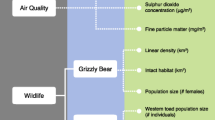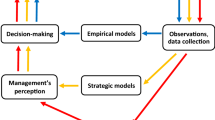Abstract
Our understanding of natural ecosystems can be measured by our ability to predict their responses to external disturbances. Predictions made during environmental impact assessment (EIA) for major development projects are hypotheses about such responses, which can be tested with data collected in environmental monitoring programmes. The systematic comparison of predicted and actual impacts has been termed environmental impact audit. Ecosystem disturbances associated with major resource developments, though of lesser magnitude than those associated with natural cataclysms, are generally of far greater magnitude than those which can be applied experimentally. Environmental audit can hence provide critical tests of theory in a number of natural sciences. It is also needed to improve the scientific content of EIA. Audits of 4 and 29 EISs respectively have been carried out previously in the UK and USA, but this is the first national scale audit for any country. It is also the first attempt to select, from the many vague statements in EISs, only those predictions that are scientifically testable, and to determine and analyse their quantitative accuracies. Its principal results are as follows. The average accuracy of quantified, critical, testable predictions in environmental impact statements in Australia to date is 44%±5% s.e. Predictions where actual impacts proved more than expected were on average significantly (p<0.05) less accurate (33%±9%) than those where they proved as or less severe (53%±6%).
Similar content being viewed by others
References
Anon (editorial): 1975, ‘An audit may be dangerous to your health’, Water Wastes Engin. 12, 17.
BissetR.: 1985. ‘Post-development audits to investigate the accuracy of environmental impact predictions’, Zeitsch. Umweltpolitik 4/84, 463–484.
BissetR. and TomlinsonP.: 1988, In WathernP. (ed.) Environmental Impact Assessment: Theory and Practice, 115–157. Unwin Hyman, London.
BlakesleeH. W., and GrabowskiT. M.: 1985, A Practical Guide to Plant Environmental Audits, Von Nostrand Reinhold, New York.
BuckleyR. C.: 1987, Environmental Planning Techniques, SADME, Adelaide.
BuckleyR. C.: 1988a, ‘Critical problems in environmental planning and management’, Environ. Plan. Law J. 5, 206–225.
BuckleyR. C.: 1988b, ‘A national environmental audit’, AusIMM Bull. and Proc. 293, 25–26.
BuckleyR. C.: 1989a, Environmental Audit: Short Course Handbook, 7Vols. Bond University, Gold Coast.
BuckleyR. C.: 1989b, Precision in Environmental Impact Prediction: First National Environmental Audit, Australia, CRES/ANU Press, Canberra.
BuckleyR. C.: 1989c, ‘What's wrong with EIA?’ Search, 20, 146–147.
CanterL. W.: 1984, ‘Environmental impact studies in the United States.’ In ReidelD. (ed.) W.H.O. Perspectives on Environ. Impact Assess. Report, 15-24. W.H.O. Geneva.
CanterL. W.: 1985, ‘Impact prediction auditing’, Environ. Profess. 7, 255.
CulhaneP. J.: 1987, ‘The precision and accuracy of U.S. environmental impact statements’, Environ. Monitor. Assess. 8, 217–238.
HallW. N.: 1985, ‘Environmental audits: a corporate response to Bhopal’, Environ. Forum 4, 36.
HarrisonL. L. (Ed.): 1984, The McGraw-Hill Environmental Auditing Handbook: A Guide to Corporate and Environmental Risk Management, McGraw-Hill, New York.
Henderson, L. M.: 1987, ‘Difficulties in impact prediction auditing’, Environmental Impact Assessment Worldletter, May/June 1987, pp. 9–12.
KnightM.: 1985, Review of Seven Environmental Assessments Carried Out Between 1975 and 1982, Victoria, Ministry for Planning and Environment, Melbourne: unpublished report.
LevinM. H.: 1984, ‘An EPA response on confidentiality in environmental auditing’, Environ. Law Reporter 13, 103–146.
McCallumD. R.: 1987, ‘Follow-up to environmental impact assessments: learning from the Canadian Government experience’, Environ. Monitor Assess. 8, 199–216.
Moncrieff, I., Shea, M. L. and Torrens, L. W.: 1985, ‘An environmental performance audit of selected pipeline projects in Southern Ontario’, In: Environment Canada, Proc. Conf. on Audit and Evaluation in Environ. Assessment and Management, Banff, Oct. 13–16, 1, 145–159.
New Zealand Commission for the Environment: 1985, Environmental Impact Assessment Workshop: Issues. NZCE, Wellington.
TomlinsonP., and AtkinsonS. F.: 1987a, ‘Environmental audits: proposed terminology’, Environ. Monitor. Assess. 8, 187–198.
TomlinsonP., and AtkinsonS. F.: 1987b, ‘Environmental audits: a literature review’, Environ. Monitor. Assess. 8, 239.
WrightR. S., TewE. L., DeckerC. E., vonLehmdenD. J. and BarnardW. F.: 1987, ‘Performance audits of EPA protocol gases and inspection and maintenance calibration gases’, J. Air Pollut. Control Assoc. 37, 384.
Author information
Authors and Affiliations
Rights and permissions
About this article
Cite this article
Buckley, R. Auditing the precision and accuracy of environmental impact predictions in Australia. Environ Monit Assess 18, 1–23 (1991). https://doi.org/10.1007/BF00394475
Issue Date:
DOI: https://doi.org/10.1007/BF00394475




